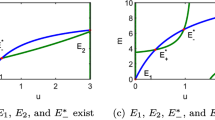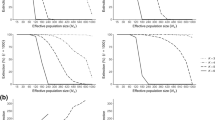Abstract
The interplay between space and evolution is an important issue in population dynamics, that is particularly crucial in the emergence of polymorphism and spatial patterns. Recently, biological studies suggest that invasion and evolution are closely related. Here, we model the interplay between space and evolution starting with an individual-based approach and show the important role of parameter scalings on clustering and invasion. We consider a stochastic discrete model with birth, death, competition, mutation and spatial diffusion, where all the parameters may depend both on the position and on the phenotypic trait of individuals. The spatial motion is driven by a reflected diffusion in a bounded domain. The interaction is modelled as a trait competition between individuals within a given spatial interaction range. First, we give an algorithmic construction of the process. Next, we obtain large population approximations, as weak solutions of nonlinear reaction–diffusion equations. As the spatial interaction range is fixed, the nonlinearity is nonlocal. Then, we make the interaction range decrease to zero and prove the convergence to spatially localized nonlinear reaction–diffusion equations. Finally, a discussion of three concrete examples is proposed, based on simulations of the microscopic individual-based model. These examples illustrate the strong effects of the spatial interaction range on the emergence of spatial and phenotypic diversity (clustering and polymorphism) and on the interplay between invasion and evolution. The simulations focus on the qualitative differences between local and nonlocal interactions.
Similar content being viewed by others
References
Aldous D. (1978). Stopping times and tightness. Ann. Probab. 6: 335–340
Bolker B. and Pacala S.W. (1997). Using moment equations to understand stochastically driven spatial pattern formation in ecological systems. Theor. Popul. Biol. 52: 179–197
Bolker B.M. and Pacala S.W. (1999). Spatial moment equations for plant competition: understanding spatial strategies and the advantages of short dispersal. Am. Nat. 153: 575–602
Bossy M., Gobet E. and Talay D. (2004). A symmetrized Euler scheme for an efficient approximation of reflected diffusions. J. Appl. Probab. 41: 877–889
Champagnat N., Ferrière R. and Méléard S. (2006). Unifying evolutionary dynamics: from individual stochastic processes to macroscopic models. Theor. Popul. Biol. 69: 297–321
Champagnat, N., Ferrière, R., Méléard, S.: Individual-based probabilistic models and various time scaling approximations in adaptive evolution. In: Proceedings of the 5th Conference on Stochastic Analysis, Random Fields and Applications, Ascona 2005, Prog. Prob. Ser., Birkauser (to appear) (2006)
Desvillettes L., Ferrière R. and Prévost C. (2004). Infinite dimensional reaction–diffusion for population dynamics. Preprint CMLA, ENS Cachan,
Dieckmann U. and Doebeli M. (1999). On the origin of species by sympatric speciation. Nature 400: 354–357
Dieckmann U. and Law R. (2000). Relaxation projections and the method of moments. In: Dieckmann, U., Law, R. and Metz, J.A.J. (eds) The Geometry of Ecological Interactions: Symplifying Spatial Complexity, pp 412–455. Cambridge University Press, Cambridge
Dieckmann U., Law R. and Metz J.A.J. (2000). The Geometry of Ecological Interactions: Symplifying Spatial Complexity. Cambridge University Press, Cambridge
Doebeli M. and Dieckmann U. (2003). Speciation along environmental gradients. Nature 421: 259–263
Durrett R. and Levin S. (1994). The importance of being discrete (and spatial). Theor. Popul. Biol. 46: 363–394
Durrett R. and Levin S. (1994). Stochastic spatial models: a user’s guide to ecological applications. Phil. Trans. R. Soc. Lond. B 343: 329–350
Endler J.A. (1977). Geographic Variation, Speciation and Clines. Princeton university Press, Princeton
Flierl G., Grünbaum D., Levin S. and Olson D. (1999). From individuals to aggregations: the interplay between behaviour and physics. J. Theor. Biol. 196: 397–454
Fournier N. and Méléard S. (2004). A microscopic probabilistic description of a locally regulated population and macroscopic approximations. Ann. Appl. Prob. 14: 1880–1919
Geritz S.A.H., Metz J.A.J., Kisdi E. and Meszena G. (1997). The dynamics of adaptation and evolutionary branching. Phys. Rev. Lett. 78: 2024–2027
Gobet E. (2001). Euler schemes and half-space approximations for the simulation of diffusion in a domain. ESAIM PS 5: 261–293
Grant P.R. and Grant B.R. (2002). Unpredictable evolution in a 30-year study of Darwin’s finches. Science 296: 707–711
Hassel M.P. and May R.M. (1974). Aggregation in predators and insect parasites and its effects on stability. J. Anim. Ecol. 43: 567–594
Hassel M.P. and Pacala S.W. (1990). Heterogeneity and the dynamics of host parasitoid interactions. Phil. Trans. R. Soc. Lond. B 330: 203–220
Jacod J. and Shiryaev A.N. (1987). Limit Theorems for Stochastic Processes. Springer, Heidelberg
Joffe A. and Métivier M. (1986). Weak convergence of sequences of semimartingales with applications to multitype branching processes. Adv. Appl. Probab. 18: 20–65
Lépingle D. (1995). Euler scheme for reflected stochastic differential equations. Math. Comp. Simul. 38: 119–126
Lewis M.A. and Pacala S. (2000). Modeling and analysis of stochastic invasion processes. J. Math. Biol. 41: 387–429
McGlade J. (1999). Advanced Ecological Theory: Principles and Applications. Blackwell, Oxford
Mayr E. (1963). Animal Species and Evolution. Harvard University Press, Cambridge
Méléard S. and Roelly S. (1993). Sur les convergences étroite ou vague de processus à valeurs mesures. C. R. Acad. Sci. Paris STr. I Math. 317: 785–788
Metz J.A.J., Geritz S.A.H., Meszéna G., Jacobs F.A.J. and Heerwaarden J.S. (1996). Adaptive dynamics, a geometrical study of the consequences of nearly faithful reproduction. In: Verduyn Lunel, S.M. (eds) Stochastic and Spatial Structures of Dynamical Systems., pp 183–231. North Holland, Amsterdam
Mollison D. (1977). Spatial contact models for ecological and epidemic spread. J. R. Stat. Soc. B 39: 283–326
Murray J.D. (1989). Mathematical Biology. Biomathematics texts 19. Springer, Berlin
Niwa H.S. (1994). Self-organizing dynamic-model of fish schooling. J. Theor. Biol. 171: 123–136
Phillips B.L., Brown G.P., Webb J.K. and Shine R. (2006). Invasion and the evolution of speed in toads. Nature 439: 803
Prévost, C.: Applications des équations aux dérivées partielles aux problèmes de dynamique des populations et traitement numérique. PhD thesis, Université d’Orléans, France (2004)
Rand D.A., Keeling M.J. and Wilson H.B. (1995). Invasion, stability and evolution to criticality in spatially extended, artificial host–pathogen ecologies. Proc. R. Soc. Lond. B 259: 55–63
Roelly-Coppoletta S. (1986). A criterion of convergence of measure-valued processes: application to measure-valued branching processes. Stochastics 17: 43–65
Roelly S. and Rouault A. (1990). Construction et propriétés de martingales des branchements spatiaux interactifs. Int. Stat. Rev. 58(2): 173–189
Roughgarden J. (1972). Evolution of niche width. Am. Nat. 106: 683–718
Rudin W. (1987). Real and Complex Analysis, 3rd edn. McGraw-Hill, New York
Sato K. and Ueno T. (1965). Multi-dimensional diffusion and the Markov process on the boundary. J. Math. Kyoto Univ. 4(3): 529–605
Shepp L.A. (1979). The joint density of the maximum and its location for a Wiener process with drift. J. Appl. Probab. 16: 423–427
Thomas C.D., Bodsworth E.J., Wilson R.J., Simmons A.D., Davies Z.G., Musche M. and Conradt L. (2001). Ecological and evolutionary processes at expanding range margins. Nature 411: 577–581
Tilman D. and Kareiva P. (1996). Spatial Ecology: The Role of Space in Population Dynamics and Interspecific Interactions. Princeton University Press, Princeton
Young W.R., Roberts A.J. and Stuhne G. (2001). Reproductive pair correlations and the clustering of organisms. Nature 412: 328–331
Author information
Authors and Affiliations
Corresponding author
Rights and permissions
About this article
Cite this article
Champagnat, N., Méléard, S. Invasion and adaptive evolution for individual-based spatially structured populations. J. Math. Biol. 55, 147–188 (2007). https://doi.org/10.1007/s00285-007-0072-z
Received:
Revised:
Published:
Issue Date:
DOI: https://doi.org/10.1007/s00285-007-0072-z
Keywords
- Spatially structured population
- Adaptive evolution
- Stochastic individual-based model
- Birth-and-death point process
- Reflected diffusion
- Mutation and selection
- Nonlinear reaction–diffusion equation
- Nonlocal interaction and local interaction
- Clustering
- Polymorphism
- Invasion and evolution




